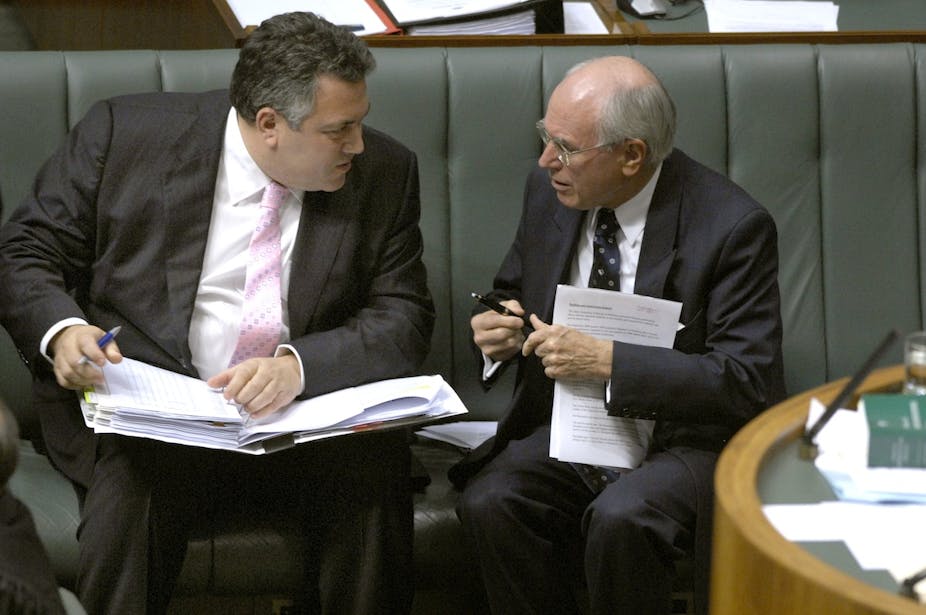The Abbott government is about to unveil a new A$10 billion infrastructure package in its first budget. Apparently it is to be funded by a “special immediate measure” in the form of a levy imposed on high-income earners over a four-year period.
Discussions about this likely measure seem to have focused on whether or not this levy is a tax. I see it as a hypothecated tax, not unlike the 3+3 fuel excise or the gun buyback levy or the Queensland floods levy, all of which were short-term, designed to cover particular spending needs but operated in the same way as any other tax.
In focusing on the largely insignificant tax-versus-levy issue, discussion has largely ignored the spending side of this special measure, the link to the asset recycling plan being devised by Treasurer Joe Hockey.
About A$5 billion is to be set aside to encourage states to privatise their assets by providing a 15% “bonus” payment for privatising state-owned assets, which I assume to include physical assets and public sector agencies and, perhaps, service delivery mechanisms.
What about regulation?
The assumptions underpinning such a policy are breathtaking in their disregard for evidence and for their promulgation of simplistic propositions about the relative efficiency of public and private sector management. Importantly, the policy does not recognise the fundamental link between ownership and regulation, and the impact that changes to the regulatory regime, which usually accompanies privatisation, have on market behaviour and the eventual success of any privatising activity.
For example, in promoting the privatisation of Medibank Private, Treasurer Hockey, and Peter Costello before him in 2006, claim that privatisation will reduce private health insurance premiums or at least restrain their growth. But this claim is largely dependent on government being the arbiter (the regulator) of proposals from private health insurance providers for any increases in premiums.
The impact on premiums will also depend on whether there are other regulatory measures imposed to accompany the sale of Medibank Private, such as limits to market share, conditions attached to ownership change (perhaps in the same way that takeover bids involving the four pillars in the banking sector are considered) and, importantly, the management of community service obligations such as any discounts for pensioners or safety net arrangements for other users.
In the debates surrounding the abandoned sale of Medibank Private in 2006, Labor suggested that retaining public ownership would also restrain the growth in premiums, arguing that the significant market share held by the government provider enabled the government to exercise price control through competition in the market place. In short, the impact on premiums had little to do with ownership, rather it depended on the regulatory arrangements that applied and the role that government would play in such arrangements.
Private isn’t always better
This brings us to the issue of ownership and its relationship to performance. There is no credible evidence that performance differences between public and private organisations undertaking the same services in similar ways can be attributed to ownership. Over and over again, we see that differences in performance and efficiency relate to the environment in which the organisations operate, especially the regulatory regimes involved.
There is no substance to the argument that private banks, for example, would be any more, or less, efficient than publicly-owned ones, working in the same environments. Differences in performance might relate to, say, government decisions that branches of the publicly-owned bank should be placed in more remote communities which might prove to be less financially viable but will enable greater access to banking services.
Or that publicly-owned hospitals with the same regulation relating to admissions and the like would, by virtue of their ownership, be any less (or more) efficient than their privately-owned counterparts. Or that performance differences found at Sydney Airport under public ownership (and managed by Federal Airports Corporation) in comparison to its subsequent private owners were related to ownership rather than to the different management models used coupled with changes from higher to “lighter” government regulation that accompanied airport privatisation.
And so it is with state-owned assets and organisations. There is nothing in robust academic studies (beyond individual cases, often selectively drawn to support the propositions of superior private, or public, ownership) to back the underlying assumption that state-owned assets will intrinsically be better off in private hands. To propose a policy based on that dubious assumption, and then attach a value of A$5 billion to it, is not only simplistic but leaves the government open to charges of irresponsible policy making based more on belief than on evidence.
Recycled ideology
Unfortunately, it reflects a re-emergence, or recycling, of some of the privatisation strategies introduced by the Thatcher and Howard governments. Driven by goals such as blunting union power, providing windfalls for conservative supporters, reducing the size of government and other essentially normative political goals, we witnessed the divestment of many public organisations justified by allegations that they were inefficiently run.
While there were numerous examples of successful privatisations, the literature is replete with examples of poorly managed ones. As a consequence, the public has lost valuable assets and been short-changed by their undervaluing; and governments have paid enormous fees to the consultocracy to manage the processes involved, have sometimes been required to take repair action such as buying back failed privatised entities and have foisted on the public more inefficient private replacement organisations over which they have less control. All because of hasty, ideologically-driven policies of privatisation.
I hope the states will be able to resist the 15% bribe and undertake due diligence of any potential asset sale. This should take into account necessary changes to the regulatory regimes that should, in almost all cases, accompany proposals for divestment of publicly-owned assets. The public deserves from this government a more mature, evidence-based and more nuanced policy rather than a simplistic recycled policy from the Howard era.

